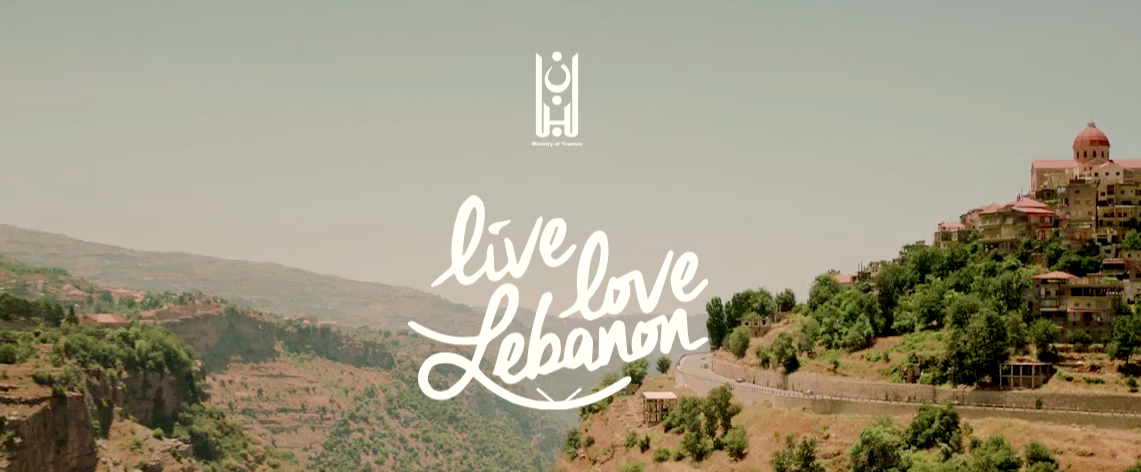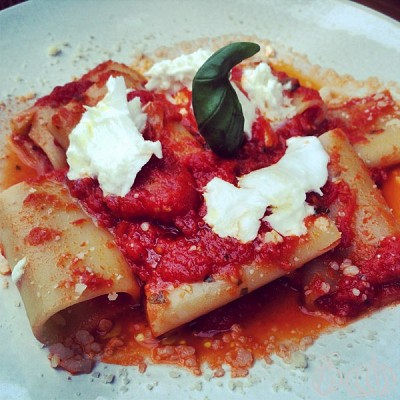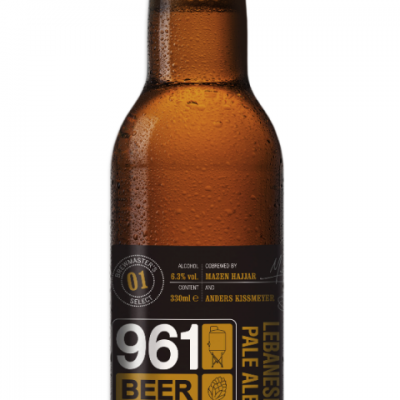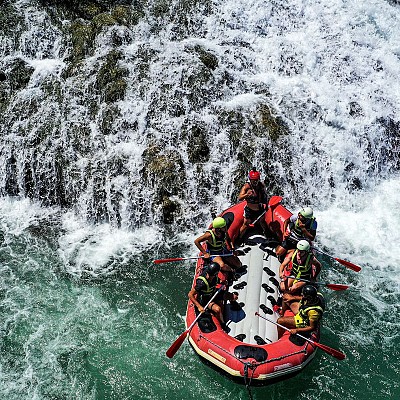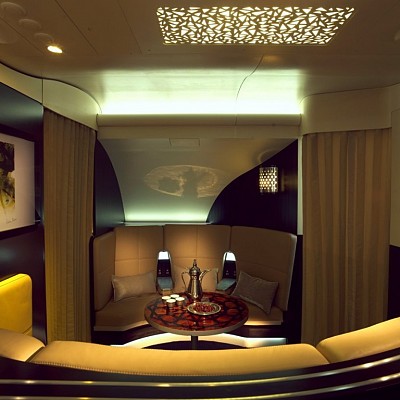THE INFLIGHT MAP FLASHES. BLUE. GREEN. BROWN.
That’s our first view of Lebanon, a lush, green ribbon draped between the Mediterranean Sea and the deserts of the Middle East. Even on a two-bit screen it’s a striking visual of why this land has been so important to so many people. The Phoenicians, the Ancient Greeks, the Persians, the Romans, the Ottomans, the Crusaders, the Arabs and the French —for 8,000 years an unbelievable who’s who of greats have shaped and been forever shaped by this incredible sliver of land. The countryside is scattered with breathtaking reminders that this tiny country was a land of empires.
Even Lebanon’s magnificent 3,000-year-old cedars have a richer history than most civilizations.

It’s well after midnight when we land but as Yousif, our driver, whips down Beirut’s seaside promenade, The Corniche, light, music, and people spill out of big hotels and small cafes.

The summer air is warm without being at all oppressive or muggy. We’re too excited to sleep but talk ourselves into it knowing how much we have on our plate in the morning.
If you know us, you know that we came for more than history. We came to eat. And there aren’t many places better suited for an eating holiday than Lebanon.
Three years ago we started our blog, Pasture Braised, with one rule: look for good ingredients, and good food will find you. In Lebanon, good food finds you everywhere.
Our first stop is the great incubator of Lebanese regional cuisine, Tawlet, sister restaurant of Beirut’s farmers market, Souk el Tayeb. Each day both cook and menu change as rural “housewives” bring local ingredients and home recipes into the Beirut kitchen to tell their stories through food. Over lunch we also befriend Kamal Mouzawak, the man behind Tawlet and Lebanon’s locally grown movement.
Mani’ish with Za’atar and dried yogurt for breakfast…tabouli and kebbeh for our bulgur fix midday… never ending mezza spreads…a break for backgammon and narghile…capped off if (somehow) still hungry with street side falafel and shawarma…we can get used to this lifestyle. Very easily.
You could spend many (many, many) happy days eating your way through Beirut. But we are off to explore rural Lebanon.


IF YOU KNOW US, YOU KNOW THAT WE CAME FOR MORE THAN HISTORY. WE CAME TO EAT. AND THERE AREN’T MANY PLACES BETTER SUITED FOR AN EATING HOLIDAY THAN LEBANON.

AT JUST OVER 4,000 SQUARE MILES (THAT’S SMALLER THAN ALL BUT TWO U.S. STATES) WE KNEW LEBANON WAS A COMPACT COUNTRY. BUT IT'S STILL THRILLING TO REALIZE HOW ACCESSIBLE EVERYTHING IS.
With Beirut positioned roughly halfway up the coast, nowhere is further than a half-day’s drive from the capital (and that’s at a normal pace, before factoring in that you’re in a country where everyone drives like a professional stunt double).
An absolute must-must-must-do day trip is the cool, dreamy caves of the Jeita Grotto. We’ve toured a surprising amount of caves around the world, and can confidently say that Jeita is the most magnificent by far. There are two limestone chambers, upper and lower, that burrow back into the hillside for an astonishing 5.5 miles. In the upper cave, an Escher-inspired walkway leads you over glistening stalagmites and past the world’s largest stalactite. The lower cave wows with an otherworldly backlit boat ride across the "Dark Lake".
THERE’S NO TRUTH TO IT, BUT IT’S EASY TO IMAGINE TOLKIEN DREAMING UP HIS “GLITTERING CAVES” WHILE FLOATING THROUGH THE GROTTO.
ON THE MAP SINCE BIBLICAL TIMES
Emerging from below ground, we seek out glittering views of the Mediterranean high above ground from Our Lady of Lebanon.
Lebanon is famously home to 18 religious communities. With more monasteries, mosques, hermitages, and shrines than you could visit in a reincarnated lifetime, faithful from around the world flock to this land of pilgrimage.
We watch a ferociously beautiful sunset from the Monastery of Saint Anthony, a beguiling labyrinth that was chiseled into a hillside rock face at the beginning of the 7th century. As we wind through the Qadisha Valley (or Valley of the Saints) on the drive to poet Kahlil Gibran’s hometown of Bcharre, we have a spiritual encounter of another sort.
A herd of goats flood the road. We compulsively stop the car and jump out to follow their Bedouin herdsmen—urbanites drawn to these bucolic nomads like children to the pied piper. They turn towards us, waving and yelling. Have we overstepped boundaries? Are we not welcome? Our friend Randi translates: they’re inviting us up for a warm glass of fresh goat’s milk
OUR FRIEND RANDI TRANSLATES: THEY’RE INVITING US UP FOR A WARM GLASS OF FRESH GOAT’S MILK.

RURAL LEBANON TAKES OUR BREATH AWAY DAY AFTER DAY.
We immediately fall in love with the beautifully preserved town of Douma. It’s hard not to fall in love walking centuries-old cobblestone streets with wildly trellised grapevines growing overhead. Douma coaxes a slower pace, and we meander aimlessly, swapping curious smiles with hardened but happy looking locals.
We’re here for lunch at Kamal’s glorious work-in-progress country home just past the village. He’s generously invited us to join a fascinating mélange of progressive thinkers from all over the map. His never-ending celebration of food and Lebanese heritage seems to attract and bring out the best in people. They’re still restoring the tiles in the entryway and the furniture hasn’t yet arrived, but somehow there are just enough chairs and tables for a massive farm-to-table picnic under the trees.
Country life isn’t totally sleepy. We rent ATVs near Mt. Lebanon and spend the afternoon tearing up the foothills. As we round a long row of poplars, pop music reverberates from a villa where a crew of young Beirutis are escaping the summer heat in round-the-clock-party fashion.
In a country where socializing is a national pastime, it’s little wonder that wine is often on the menu. With 42 wineries and growing, Lebanon is fast becoming an international wine destination.
We’re blown away by the winemakers’ care and quality, especially the eco-minded production at Ixsir. We notice how similar Lebanese wine country looks to the Napa Valley at home in California.


We came to Lebanon salivating for classic mezze: creamy hummus, charred and smoky eggplant dishes, fresh fattoush salads, tart labneh yogurt. We have our fill and so, so much more. Two of our favorite classic spreads come from Beirut’s Abdel Wahab el-Inglezi with its proliferation of hummus and an eggplant dish called the monk’s salad that we still can’t get out of our heads, and Hotel Chbat in Bcharré—where the charming owner entertains us with an oddball collection of monastery and boutique vineyard wines.

We’re also incredibly impressed with new-guard restaurants putting their thoughtful, technique-rich spin on these traditional ingredients. We fall in love with the Parisian inspired approach to Lebanese cooking at the impeccably styled Liza, and the gorgeous pickled tuna and “deconstructed” fresh fish and eggplant plates at the splashy waterside Babel Bay. It’s said Lebanon makes 75 mezze dishes. With kitchens like Liza and Babel, that number has doubled.

The breakaway surprise star of our Beirut food tour is Souk el Akel, Beirut’s hip, grassroots Thursday night street food market. We meet the most uncanny vendors. Suzzanne, the Kibbeh Queen of Souk el Tayeb fame, is there, and so are a proliferation of young people making, amazing, soulful, international food. We have a long, tasty chat with the three young friends behind This Little Piggy, Lebanon’s first pulled-pork stand (they slow cook American-style sammies in a smoker the founder built himself!). And we meet Jamil, a passionate windsurfer with a low-key intensity, who sold every material possession he owned to open Colonel, Lebanon’s first world-class eco-friendly, independent brewery.

JAMIL INVITES US TO THE BREWERY IN HIS BELOVED SEASIDE HOMETOWN OF BATROUN. THIS IS NOT AN INVITATION TO PASS UP.
Jamil invites us to the brewery in his beloved seaside hometown of Batroun. This is not an invitation to pass up. The space is stunning. Living walls sprout foliage that keeps the building cool, the high ceilinged tasting room is furnished with upcycled materials, and the outdoor lawn is full of happy people—soon to be more as a summer music festival rolls into town. Colonel the space, the vibe, and the beer are on point. You would be lucky to have this brewery near your home living anywhere in the world.
THE ROAD TO BAALBEK
The road to Baalbek is like traveling to a completely different world. The fields around us stretch out through time and space. This wide valley floor has nourished crops for centuries, and was a breadbasket of the Roman Empire.
Current-day Baalbek, the jumping off town for the historic ruins of the Sun City, Heliopolis, is another world again.

IT’S MIDDAY AND THE COMPACT, COLORFUL STREETS ARE CROWDED.
We drive up a row of jewelers and down a strip of butcher shops. Each butcher has two or three sheep hanging in the window; some are stuffed with coriander so fresh and aromatic you’d swear you smell it through the AC in Yousif’s car.
The atmosphere changes once again at the UNESCO gates. There aren’t really words for just how majestic and just how Roman this once great city still feels. The world famous pillars of the Temple of Jupiter—six lone standing giants of 54 original titans—are the largest columns in the world. Their scale is so massive that even our crew’s professional cameras struggle getting them fully in frame.

EVEN LEBANON'S MAGNIFICENT 3,000-YEAR-OLD CEDARS HAVE A RICHER HISTORY THAN MOST CIVILIZATIONS.
Elevation does fascinating things to terrain. As we climb, farmland gives way to forest. Remember those 3,000-year-old cedar trees? They’ve found an enchanted home in reserves dotted around the country. Nearly harvested to extinction by the very civilizations their rock-hard timber helped make great, Lebanon’s cedars are now a protected national treasure.
The largest and most impressive sanctuary, Al Shouf Cedar Nature Reserve, covers a whopping 5% of the country’s land, protecting a huge diversity of flora and fauna.

THE RESERVE EVEN RAISES BEES AND PRODUCES A CEDAR HONEY, A COMPLETELY UNIQUE AND DELICIOUS INDULGENCE.
Back on the coast, in the shadow of a 13th century Crusaders castle, old Sidon’s souk is a maze of a world unto itself. Hundreds of stalls form a network of tunnels that sell the makings of a city. Butchers. Bakers. Candlestick makers (or close enough—we have a fascinating poke around the oddly beautiful Soap Museum).
It’s Ramadan so restraint is in effect. But anticipation’s in the air as people gather the necessary ingredients for the evening’s long awaited iftar meal. We buy a cut of lamb to grill later and collect an assortment of baklavas and Lebanese sweets.


Our nine days in Lebanon fly by.
Because the country is so small and so well connected, we’re able to fit so much into our days. The famous tourism slogan says Lebanon is one of the only places you can go skiing in the morning and to the beach in the afternoon. We’ll add to that it’s one of the only places you can join nomadic goat herders in the morning and sample a flight at an eco-friendly craft brewery in the afternoon.
With so many memories swirling like the Lebanon’s collage of beautiful landscapes, we’ve just left and already can’t wait to get back.
Luckily, we have a new favorite Arabic saying that should help.

YALLA. LET’S GO.
AUTHOR CREDIT: Cliff and Natalie run the food and travel blog Pasture Braised. When not traveling, they live in San Francisco with their dog, Gigi.


















